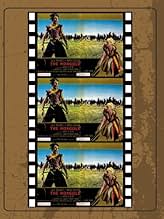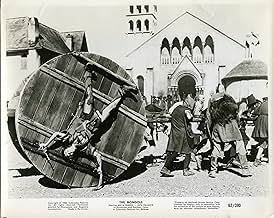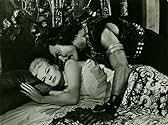Agrega una trama en tu idiomaDuring the Mongol invasion of Poland, a conflict between Mongol Emperor Genghis Khan and his oldest son Ogotai ensues when the former aims for peace and the latter itches for war and conques... Leer todoDuring the Mongol invasion of Poland, a conflict between Mongol Emperor Genghis Khan and his oldest son Ogotai ensues when the former aims for peace and the latter itches for war and conquest.During the Mongol invasion of Poland, a conflict between Mongol Emperor Genghis Khan and his oldest son Ogotai ensues when the former aims for peace and the latter itches for war and conquest.
- Dirección
- Guionistas
- Elenco
Lawrence Montaigne
- L'aleato di Stefano
- (as Lawrenc Montaigne)
Mario Colli
- Boris
- (sin créditos)
Andrej Gardenin
- Fencer
- (sin créditos)
Janine Hendy
- La danzatrice nell'harem
- (sin créditos)
Opiniones destacadas
I've wanted to watch this movie for a long time based on the performance of Jack Palance in a previous role as Atilla in "Sign of the Pagan". I wasn't disappointed in Palance's performance as Ogatai but as a whole this film was very inconsistent and horribly incorrect historically. To say the writers of this movie took liberties with history is an understatement. The great battle between the Mongols and the combined armies of Europe did take place, but not with the results described in the movie. In fact, the Mongols did have the opportunity to move much further westward into Europe, except by chance were diverted back home due to the death of the emperor and than later resumed their campaign toward the south/west and the Middle East, considered more attractive at this time in history. The movie does have some lavish costumes and epic battles, but it also often repeats the same footage over and over again. This movie actually had some potential with the amount of money it seemed to have in its production, but somebody dropped the ball in terms of editing, music and story. Blond haired Anita Ekberg as Ogatai's lover at first glance seems absurd, but plausible when you consider that the Mongols conquered all of Asia and most of Eastern Europe. Her acting is actually fairly good. The movie is worth seeing if your a fan of Jack Palance, his character of Ogatai is a unique one.
For those of you who got a kick out of Mr. Palance's Attila the Hun in SIGN OF THE PAGAN this film gives you a better, new improved version of his unique brand of barbarity. This man's GOT to have a war or he'll just be miserable. He'll lie, cheat, steal, connive- do just anything in order to HAVE THAT WAR. This is type A personality taken to it's most outer extreme. You can really feel the almost unbearable frustration he seems to experience when his old dad Genghis Khan tells him that they're going to try for a peaceful solution with the Poles. Well, anyhow, it all ends badly for Jack (and dad). Anita Ekberg as a truly ice cold partner/lover of Jack's is fascinating to watch as well in a sort a somnambulistic way; she's pure deceit. And I was also rather entranced by the head Polish knight's seeming death wish in his relentless, driven fixed idea of obtaining peace with the Mongols. Discouraged at almost every turn, the son of a gun just would not give up and finally came out on top in the end (and got the girl, too). A good lesson in superhuman determination.
Historical adventure flick, but average epic movie, with known actors and a lot of extras, in fact it packs a cast of hundreds, if not of thousands. Genghis Khan: Roldano Lupi, lustful of territory and power invades Poland along with his encroaching army , sweeping in blood and fire the European countries. Then the Polish prince attempts to make peace but Attila's son, Ogotai : Jack Palance, rejects it , being supported by his lover, the Swedish/Italian model-actress Anita Ekberg who portrays Hulina, an action woman perfectly capable matching him in badness and brutality, both of whom wish wage war. Along the way they try to conquer the Polish stronghold of Cracow. While the Poles, wary of the approaching Mongols send Stefan of Cracow : Franco Silva, to negotiate a peace arrangement with Genghis Khan and his another son Temujin : Gabriele Antonini. By the way Stefan of Cracow enters into a love/hate relationship with a Polish village girl who finishes falsely believing that Stefan klled her would-be betrothed.
This spectacular sword and sandal film shot in Yugoslavia packs noisy action, large frames of men on horseback ready to fight, breathtaking battles , a scorning love story, thrills , hokey historical happenings and a cast of thousands. The picture is partially based on historic events about the Mongol encroachment over North and Central Europe. Weak screenplay by Luciano Martino, Ernesto Gastaldi, Ugo Guerra, blending various facts with no much sense. Overacting by Jack Palance, as usual, as the violent and cruel Ogotai, he is at his menacing here . Palance dominates this historical adventure with his hysterical acting as a relentless warrior with only one thrist : bloody revenge and annihilation. Palance played several exotic/historical roles featuring plenty of treachery and deviousness, such as as The Silver Chalice, Attila, Revak the rebel, Rosmunda and Alboino, The horsemen, Barrabas, among others. He is well accompanied by a good support cast, such as : Antonella Lualdi, Franco Silva, Roldano Lupi, Montaigne, Pierre Cressoy, Gabriella Pallotta, Gabriele Antonini, George Wang and Gianni Garco : Sartana.
It contains colorful cinematography by Aldo Giordani and epic in score, shot on location in habitual Yugoslavia outdoors . And rousing and moving musical score by Mario Nascimbene. This costumer motion picture was regularly directed by Andre De Toth (Carson City, House of wax, Springfield rifle, Passport to Suez, Man in the saddle, Riding shotgun, Pitfall, Tanganika, Hidden fear), Leopoldo Savona (Two little orphans, Apocalypse Joe, Killer kid, Byleth, Fra Diavolo, Texas the Red) and Riccardo Freda (Il vampiri, Teodora, Horrible Dr Hitchcock, Beatriz Cenci, Benbenutto Cellini, Spartaco, Maciste in court of the great Khan), this latter uncredited. Rating 5.5/10. Passable and acceptable but mediocre.
This spectacular sword and sandal film shot in Yugoslavia packs noisy action, large frames of men on horseback ready to fight, breathtaking battles , a scorning love story, thrills , hokey historical happenings and a cast of thousands. The picture is partially based on historic events about the Mongol encroachment over North and Central Europe. Weak screenplay by Luciano Martino, Ernesto Gastaldi, Ugo Guerra, blending various facts with no much sense. Overacting by Jack Palance, as usual, as the violent and cruel Ogotai, he is at his menacing here . Palance dominates this historical adventure with his hysterical acting as a relentless warrior with only one thrist : bloody revenge and annihilation. Palance played several exotic/historical roles featuring plenty of treachery and deviousness, such as as The Silver Chalice, Attila, Revak the rebel, Rosmunda and Alboino, The horsemen, Barrabas, among others. He is well accompanied by a good support cast, such as : Antonella Lualdi, Franco Silva, Roldano Lupi, Montaigne, Pierre Cressoy, Gabriella Pallotta, Gabriele Antonini, George Wang and Gianni Garco : Sartana.
It contains colorful cinematography by Aldo Giordani and epic in score, shot on location in habitual Yugoslavia outdoors . And rousing and moving musical score by Mario Nascimbene. This costumer motion picture was regularly directed by Andre De Toth (Carson City, House of wax, Springfield rifle, Passport to Suez, Man in the saddle, Riding shotgun, Pitfall, Tanganika, Hidden fear), Leopoldo Savona (Two little orphans, Apocalypse Joe, Killer kid, Byleth, Fra Diavolo, Texas the Red) and Riccardo Freda (Il vampiri, Teodora, Horrible Dr Hitchcock, Beatriz Cenci, Benbenutto Cellini, Spartaco, Maciste in court of the great Khan), this latter uncredited. Rating 5.5/10. Passable and acceptable but mediocre.
This was one of a number of low-brow peplums about ancient warrior tribes made in the wake of THE VIKINGS (1958) – this one even boasted a similarly rousing score by that film’s same composer, Mario Nascimbene. Others in this vein included THE COSSACKS (1960), THE TARTARS (1961) and ATTACK OF THE NORMANS (1962) – the latter being the only one in the bunch that I’ve watched, though I did lose the first one a couple of times on Italian TV.
Actually, this one turned out to be pretty good – and, I have to say, it lived up to the review on “Stracult” where special reference is made to its sequences of bloodthirsty action and sadism. Jack Palance gives the role of Ogotai – son of Asian potentate Genghis Khan – his eye-rolling all; he’s abetted by an equally evil Anita Ekberg (the mighty but battle-weary Khan himself perishes by her hand!). The unhistorical narrative involves the Mongols’ raid of Poland and, in particular, the attempts by one of the latter’s leading figures (Franco Silva) to negotiate a peace treaty with the Khan – a plan which Palance vehemently opposes and constantly schemes to thwart.
Being a relatively low-budget effort, the triple directorial credit might seem surprising: however, as the Italian credits themselves clearly indicate, this translates to being “A Film by Andre' De Toth” (implying that he was merely engaged in a supervisory capacity), “Directed by Leopoldo Savona”, and “Battle Sequences Staged by Riccardo Freda”. With this in mind, there are fewer of the latter than one would perhaps have appreciated – but these are nonetheless handled with the requisite gusto and grandeur. The rest of the film is largely taken up by various court intrigues on both sides of the fence but also a three-way Polish romance involving the aforementioned Franco Silva, Antonella Lualdi and Pierre Cressoy that tends to swamp Palance’s troubled relationship with his own wife!
As I said, the violence is really at the fore in this film – the Mongols themselves are memorably introduced on horseback dragging a statue of the Virgin Mary through the streets of a Polish city they’d just ransacked; besides, there are plenty of floggings (Ekberg herself lends a hand in the punishment of the perennially imperiled Lualdi), crucifixions (two men are even tied to the wheels of an advancing cart!), burnings at the stakes, etc. The finale, then, sees an Alexander NEVSKY (1938)-type strategy at work with the apparently fleeing Silva and his men luring the pursuing Mongol forces into a deadly swamp. The film was good enough almost to merit a *** rating from me…but, at 115 minutes, it’s quite a long haul – especially since it resorts too often to contrived (and repetitive) plotting.
Actually, this one turned out to be pretty good – and, I have to say, it lived up to the review on “Stracult” where special reference is made to its sequences of bloodthirsty action and sadism. Jack Palance gives the role of Ogotai – son of Asian potentate Genghis Khan – his eye-rolling all; he’s abetted by an equally evil Anita Ekberg (the mighty but battle-weary Khan himself perishes by her hand!). The unhistorical narrative involves the Mongols’ raid of Poland and, in particular, the attempts by one of the latter’s leading figures (Franco Silva) to negotiate a peace treaty with the Khan – a plan which Palance vehemently opposes and constantly schemes to thwart.
Being a relatively low-budget effort, the triple directorial credit might seem surprising: however, as the Italian credits themselves clearly indicate, this translates to being “A Film by Andre' De Toth” (implying that he was merely engaged in a supervisory capacity), “Directed by Leopoldo Savona”, and “Battle Sequences Staged by Riccardo Freda”. With this in mind, there are fewer of the latter than one would perhaps have appreciated – but these are nonetheless handled with the requisite gusto and grandeur. The rest of the film is largely taken up by various court intrigues on both sides of the fence but also a three-way Polish romance involving the aforementioned Franco Silva, Antonella Lualdi and Pierre Cressoy that tends to swamp Palance’s troubled relationship with his own wife!
As I said, the violence is really at the fore in this film – the Mongols themselves are memorably introduced on horseback dragging a statue of the Virgin Mary through the streets of a Polish city they’d just ransacked; besides, there are plenty of floggings (Ekberg herself lends a hand in the punishment of the perennially imperiled Lualdi), crucifixions (two men are even tied to the wheels of an advancing cart!), burnings at the stakes, etc. The finale, then, sees an Alexander NEVSKY (1938)-type strategy at work with the apparently fleeing Silva and his men luring the pursuing Mongol forces into a deadly swamp. The film was good enough almost to merit a *** rating from me…but, at 115 minutes, it’s quite a long haul – especially since it resorts too often to contrived (and repetitive) plotting.
The story of this movie takes place in the middle ages at a time when Genghis Khan's Mongolian army was threatening Europe. It centers around the adventures of a Polish knight who wants to save the town Kraków from being taken by the cruel enemy.
The creators of the movie put much effort into the scenery and even more effort into the costumes. But they did not put any effort at all into the script or into acting. The plot is as simple-minded as if it had been invented by some twelve year old boys, playing cops and robbers. The dialog consists of stupid, hollow phrases. This alone would already make the movie a bad movie.
However its weaknesses go beyond that. The background music is not only unbearable symphonic rubbish. It is also inappropriately matched to the atmosphere of the individual scenes. Even the optical aspects that seem to have been the film maker's only focus are flawed. I do not have sufficient historical knowledge to judge about the historical correctness of costumes, weapons and other equipment. But I am quite sure that ordinary Polish women in the middle ages did not possess a hairstyle, makeup, and manicure like models in the early 1960's, especially if they were hiding from the Mongolian army in the marshland.
This having been said, it is almost unnecessary to mention that even the main story line is far from telling a true story about Genghis Khan's time.
There is no reason to watch this film, as long as you do not want to see how much can go wrong simultaneously with a single movie.
The creators of the movie put much effort into the scenery and even more effort into the costumes. But they did not put any effort at all into the script or into acting. The plot is as simple-minded as if it had been invented by some twelve year old boys, playing cops and robbers. The dialog consists of stupid, hollow phrases. This alone would already make the movie a bad movie.
However its weaknesses go beyond that. The background music is not only unbearable symphonic rubbish. It is also inappropriately matched to the atmosphere of the individual scenes. Even the optical aspects that seem to have been the film maker's only focus are flawed. I do not have sufficient historical knowledge to judge about the historical correctness of costumes, weapons and other equipment. But I am quite sure that ordinary Polish women in the middle ages did not possess a hairstyle, makeup, and manicure like models in the early 1960's, especially if they were hiding from the Mongolian army in the marshland.
This having been said, it is almost unnecessary to mention that even the main story line is far from telling a true story about Genghis Khan's time.
There is no reason to watch this film, as long as you do not want to see how much can go wrong simultaneously with a single movie.
¿Sabías que…?
- TriviaPopularized by John Green's Crash Course YouTube series (three-second raid scene) every time he uses the phrase "The Mongols".
- ErroresDuring an invasion of the Mongols a character is seen dressed in a sleeveless jacket defending another nailed to a wheel. Ogotai (Jack Palance) drags him down with his whip, only this time the character has lost his sleeveless leather jacket, and is wearing only a wide shirt.
- ConexionesFeatured in Crash Course: World History: The Agricultural Revolution (2012)
Selecciones populares
Inicia sesión para calificar y agrega a la lista de videos para obtener recomendaciones personalizadas
- How long is The Mongols?Con tecnología de Alexa
Detalles
- Fecha de lanzamiento
- Países de origen
- Idiomas
- También se conoce como
- The Mongols
- Locaciones de filmación
- Productoras
- Ver más créditos de la compañía en IMDbPro
- Tiempo de ejecución1 hora 55 minutos
- Relación de aspecto
- 2.35 : 1
Contribuir a esta página
Sugiere una edición o agrega el contenido que falta



























